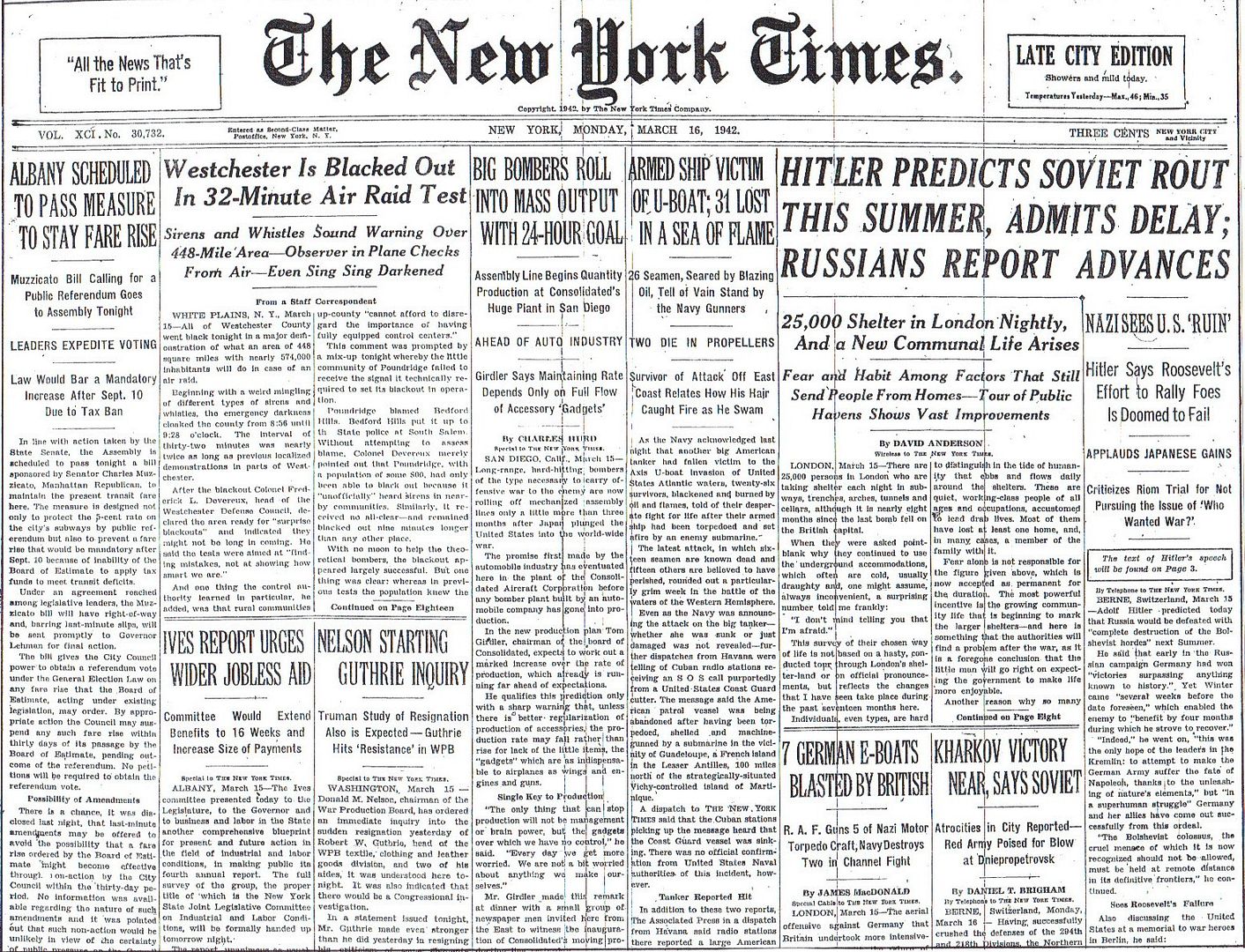
Posted on 03/16/2012 4:15:43 AM PDT by Homer_J_Simpson

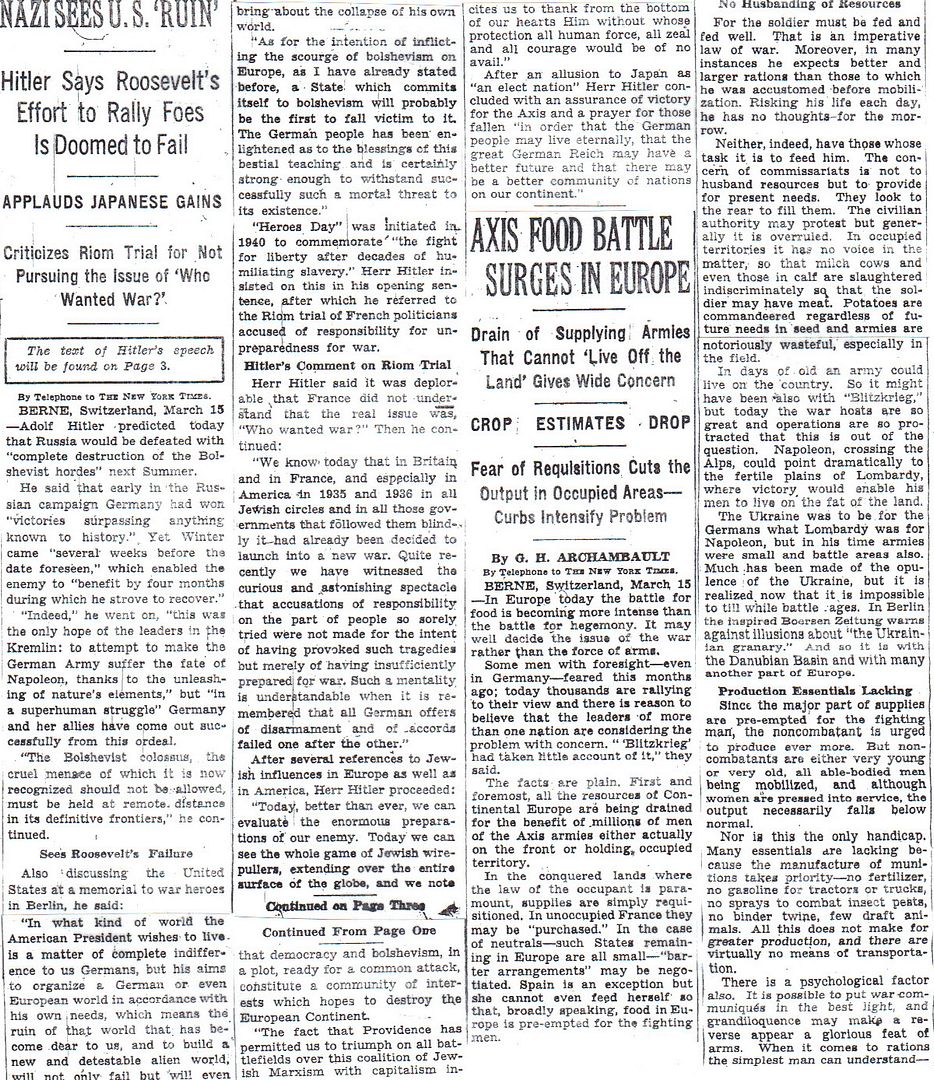
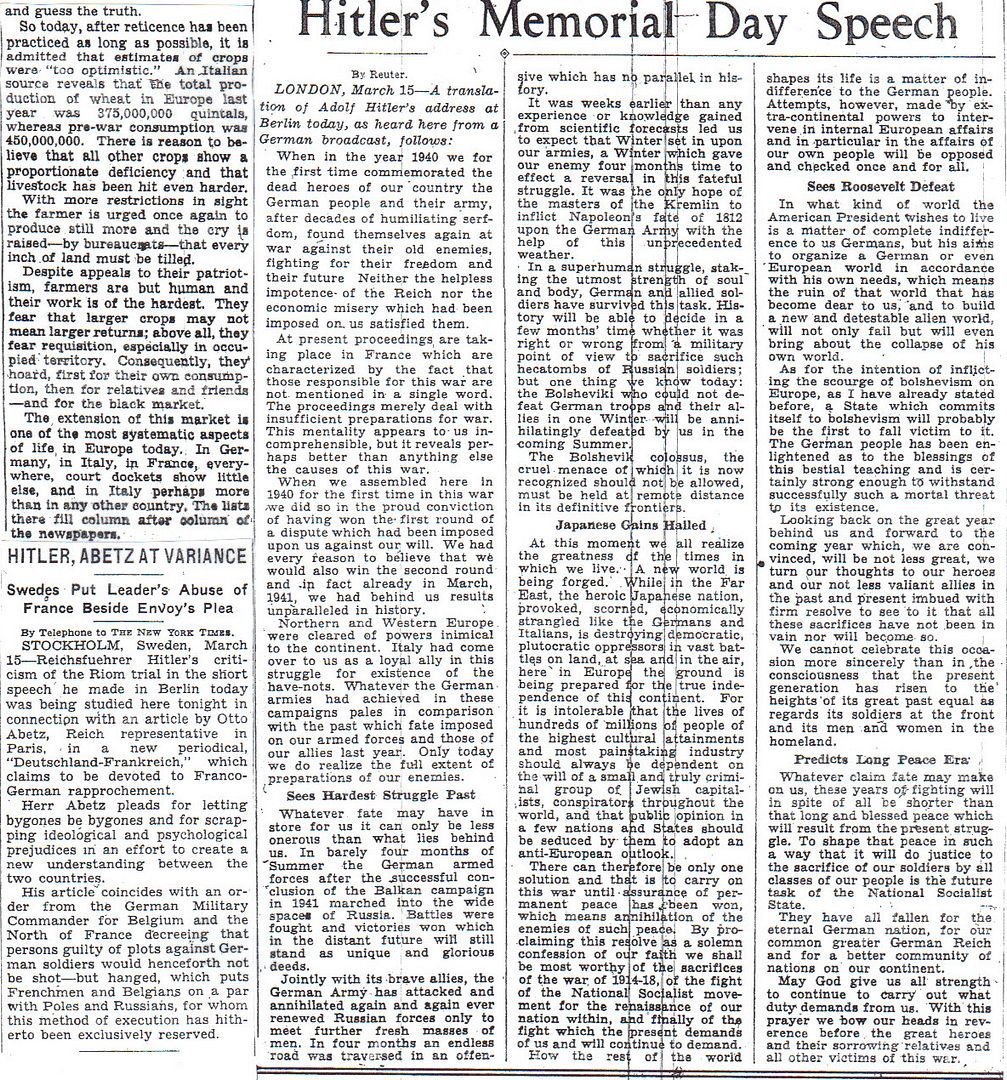

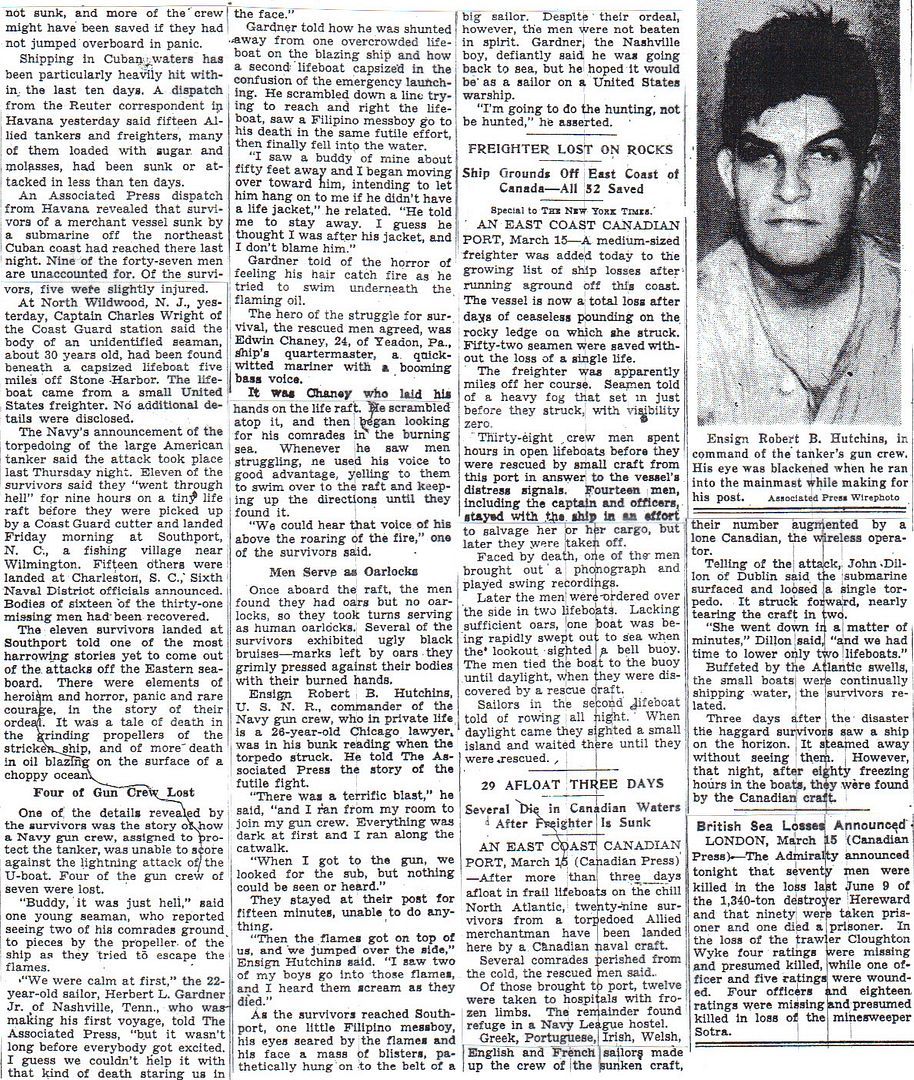
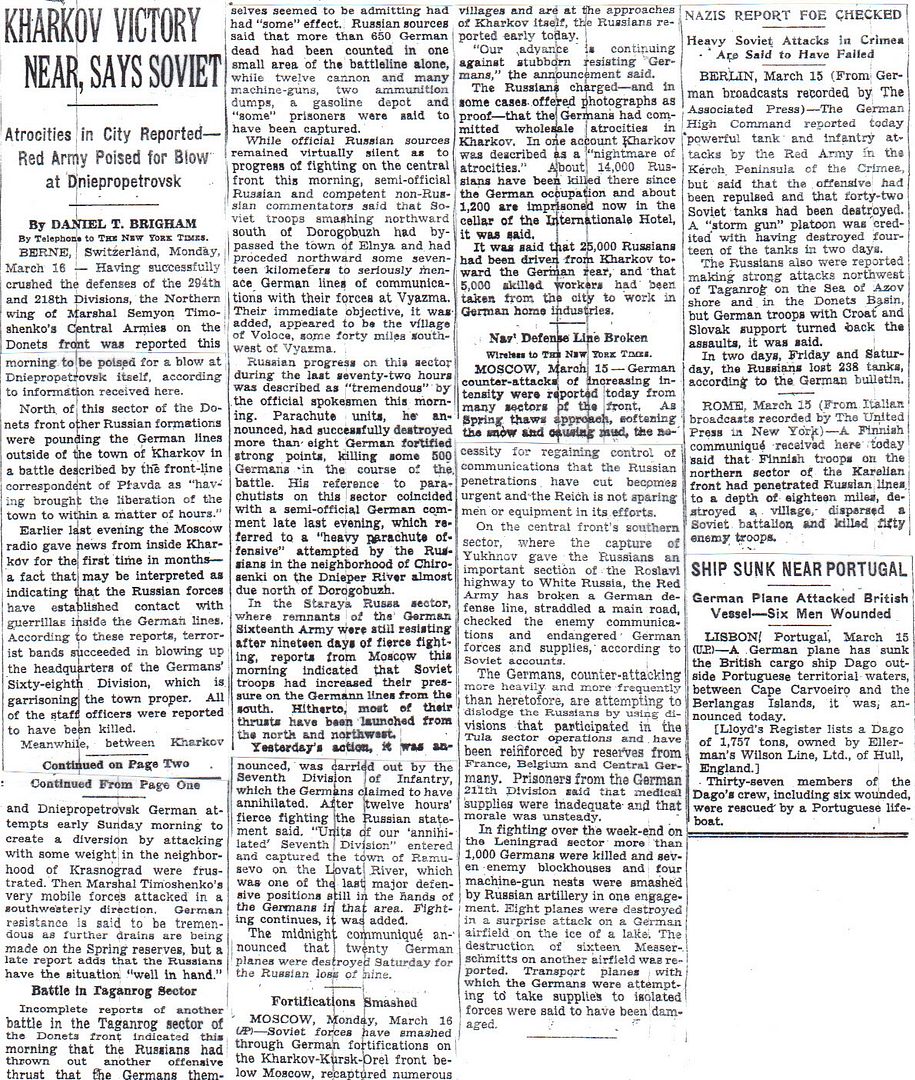
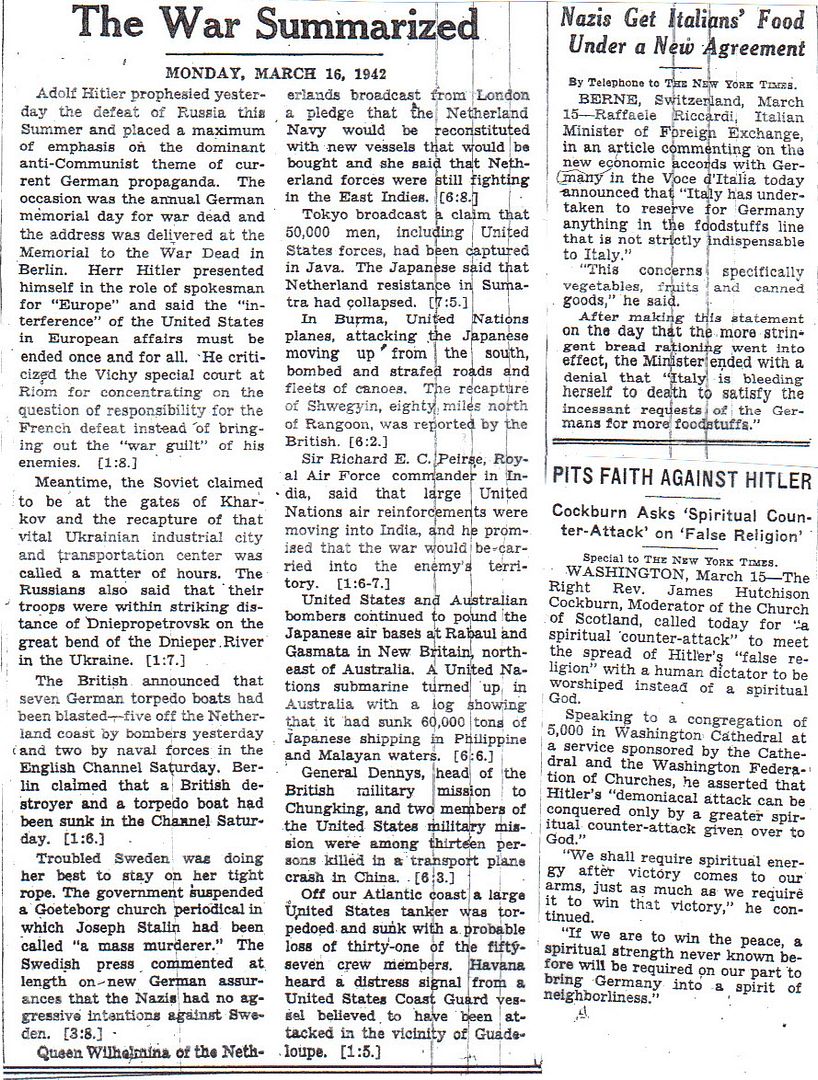


Bump.
http://www.onwar.com/chrono/1942/mar42/f16mar42.htm
Germans to strike at partisan by air
Monday, March 16, 1942 www.onwar.com
On the Eastern Front... In response to the problem of partisans in the occupied Soviet Union, the Germans set up a special air detachment in Bobruisk, with orders to bomb partisan camps and seek partisan units from the air. They will take part in Operation Munich, a three-week anti-partisan sweep to begin in the third week of March.
In the Philippines... Japanese siege guns bombard American forts in Manila Bay. One 240 mm shell detonates beneath a Fort Frank powder room, breaking up the concrete and hurling some 60 (filled) powder cans about. Miraculously, none of them explode or catch fire.
http://homepage.ntlworld.com/andrew.etherington/frame.htm
March 16th, 1942
UNITED KINGDOM: London: The Soviet ambassador asks Churchill to open a second front on mainland Europe.
British Lord Privy Seal Sir Stafford Cripps leaves London to negotiate with Indian leaders who want independence. Cripps will offer freedom after the war. Hindu leaders Mahatma Gandhi and Jawaharal Nehru demand immediate independence for a unified India while Moslem League President Mohammed Ali Hinnah wants a separate Pakistan. (Jack McKillop)
GERMANY:
U-706 commissioned.
U-423 laid down.
U-187 launched. (Dave Shirlaw)
POLAND: About 1,600 Jews are deported from the Lublin area to Belzec, the second camp after Chelmno - designed purely for the killing of Jews; it opened on 13 March, when 6,000 Jews from Mielec were murdered.
U.S.S.R.: In response to the problem of partisans in the occupied Soviet Union, the Germans set up a special air detachment in Bobruisk, with orders to bomb partisan camps and seek partisan units from the air. This unit will take part in Operation Munich, a three-week anti-partisan sweep to begin in the third week of March. (Jack McKillop)
COMMONWEALTH OF THE PHILIPPINES: Japanese siege guns bombard American forts in Manila Bay. One 240 mm shell detonates beneath a Fort Frank powder room, breaking up the concrete and hurling some 60 (filled) powder cans about. Miraculously, none of them explode or catch fire. (Jack McKillop)
Submarine USS Permit (SS-178) delivers ammunition to Corregidor Island, and evacuates the second increment of naval radio and communications intelligence people. (Jack McKillop)
At Del Monte Airfield on Mindanao Island, two B-17 Flying Fortresses arrive just before 2400 hours, the runway lit by two flares, one at each end. Lead pilot Lieutenant Frank P. Bostrom drinks eight cups of coffee to fortify himself for the return flight while mechanics repair his defective supercharger. Bostrom tells General Douglas MacArthur his party must abandon their luggage and Jean MacArthur boards carrying only a silk scarf and a coat with a fur collar. (Jack McKillop)
Station Cast (USN Intelligence, Bataan) makes the first decrypt of the Japanese naval code JN-25B, identifying AF as being Midway Island. (William L. Howard)
AUSTRALIA: Darwin was bombed in Raid no 5 (of 64). Targets were Darwin RAAF Airfield and AA Battery located at Bagot Road (probably overshoots from the airfield). (Daniel Ross)
CANADA: First arrivals at Vancouver’s Hastings Park pooling centre. All Japanese Canadian mail censored from this date. (Jack McKillop)
Frigate USS Natchez laid down Montreal, Province of Quebec.
U.S.A.: Fats Waller recorded “The Jitterbug Waltz” for Bluebird Records. (Michael Ballard)
The Maritime Commission places orders for another 234 “Liberty” ships — slow-moving 10,500-ton merchant vessels. (Jack McKillop)
Light fleet carrier USS Cabot laid down.
Minesweeper USS Tide laid down.
Destroyer USS Charles Ausburne launched.
Destroyer KNM Eskdale launched.
Destroyer USS Murray laid down. (Dave Shirlaw)
Todays issue of TIME prints two letters concerning internment/relocation
One letter is from a Japanese-American editor of the “Japan-California News”
(Los Angeles) that agrees(!) with the relocation of himself and his fellow Japanese-Americans from the West Coast on the basis of relieving the Army of having to keep a watch over them all so the Army can devote itself to defense, and that as loyal citizens they will be of service working on inland farms; plus he notes that should an attack occur on the West Coast, it would be best if the Japanese-Americans were not in the area to fall victim to vigilantism (of which California has a long history).
The second letter was from a resident of Beverly Hills who wrote that she thought there was no need to evacuate them as she detected no desire for that from typical Californians — only racists and competing local farmers wanted them gone. She also equates such an evacuation as being similar to fascist racial doctrines.
TIME later noted in this issue that German and Italian aliens over 70 years old or who had sons or brothers in the US armed forces were not interned/relocated, but these exceptions were not applied to racial Japanese, citizens or not. (William Rinaman)
CARIBBEAN SEA: At 1824, the unescorted Manaqui, dispersed from Convoy OS-20, was torpedoed and sunk by U-504 SE of Barbuda, Leeward Islands. The master, 34 crewmembers and six gunners were lost. (Dave Shirlaw)
ATLANTIC OCEAN: Two unarmed merchant tankers are sunk by German submarines off the coast of the U.S.: (1) The first is torpedoed, shelled, and irreparably damaged by U-332 about 20 miles (32 kilometres) southeast of Cape Hatteras, North Carolina; and (2) a British ship is torpedoed and sunk by U-404 about 150 miles (241 kilometres) east of Norfolk, Virginia. (Jack McKillop)
At 1955, the unescorted, unarmed and zigzagging tanker Australia was spotted by U-332 off the Diamond Shoals Lighted Buoy and within sight of the steam merchant William J. Salman and several other ships. Lighting in the distance outlined the ship against the sky, making the tanker a better target. A torpedo struck the starboard side in the engine room about 12 feet below the waterline. The explosion sent flames and smoke through the engine room skylights, destroyed the engine room fuel lines and auxiliary pipes and killed the officer and three men on watch below. Water flooded in the compartment, extinguishing the blaze as the tanker settled quickly by the stern. The surviving seven officers and 29 men abandoned ship in three lifeboats. The William J. Salman picked them up within one hour and 35 minutes and delivered them to armed yacht USS Ruby. On 17 March, they were landed at Southport, North Carolina. The stern of the Australia rested on the bottom on an even keel and was submerged with only her masts visible but all her cargo tanks intact. The total loss committee of the WSA sent a notice to the Texas Company that they could collect insurance for total loss by sinking the vessel and she was sunk on 20 March. William J. Salman was herself torpedoed and sunk by U-125 on 18 May 1942.
At 2317, the unescorted Baron Newlands was torpedoed and sunk by U-68 six miles south of Cape Palmas, Liberia. 14 crewmembers and four gunners were lost. The master, 17 crewmembers and two gunners landed at Grande Sesters and Piccaniani Cess, near Cape Palmas. (Dave Shirlaw)
"At Ilja, Poland, Jews sent to labor on a farm join Soviet partisans in a nearby forest.
In reprisal, the Germans shoot old and sick Jews in the streets, then herd more than 900 Jews into a building that is set ablaze.
All inside die."
"Although the British made a valiant effort to withdraw their forces after the April 1941 fall of Greece, not all could be rescued from there or from Crete, which fell shortly thereafter.
Among those captured were 1400 Jewish soldiers from Palestine, who had volunteered to fight in the British Army.
To keep up morale during the dark days of imprisonment in 1942, this group of eretz Israel soldiers, interned at a POW camp in upper Silesia, Germany, combined their talents to start an orchestra."
"Trumpeting his Wehrmacht, Hitler predicts that the Red Army will be "beaten in every direction in the summer.""
"German successes in 1942 led to the near collapse of the Soviet Red Army.
Casualties on both sides were enormous. Despite overwhelming odds, Soviet forces--motivated by a fierce patriotism--sought to hold the line and even push forward.
Here, Soviet soldiers crouch behind modest revetments as they fire machine guns and rifles, and tend to their wounded."
"More than 1800 Jews from Pochep, Russia, are executed."
"About two million Jews inhabited the Generalgouvernement (Nazi-occupied Poland), which was divided into the districts of Warsaw, Radom, Kraków, Lublin, and Eastern Galicia.
With that fact on his mind, Hans Frank, the head of the Generalgouvernement, assembled his top officials on December 16, 1941, and told them that Reinhard Heydrich, head of the Reich Security Main Office, was planning an important conference.
Frank's deputy, Dr. Josef Bühler, would attend on Frank's behalf.
"On January 20, 1942, Bühler was one of 15 Nazi leaders at the Wannsee Conference, which facilitated the "Final Solution."
There he urged that the Generalgouvernement's Jewish question should be "solved as quickly as possible."
"To honor Heydrich, who had been assassinated by Czech Resistance fighters in the late spring of 1942, the SS used the code name Aktion Reinhard to refer to the destruction of the Generalgouvernement's Jews.
Even before the Wannsee Conference, however, plans for the mass murder were in motion.
Directed by SS officers Odilo Globocnik and Christian Wirth, the scheme included construction of three camps whose fundamental purpose was to kill Jews.
Staffed by SS and police, quickly trained Ukrainians, and former managers of Nazi Germany's so-called "euthanasia program," Belzec, Sobibor, and Treblinka would become death factories.
More than 1.7 million Jews, most of them from the Generalgouvernement, were gassed during the 21 months of Aktion Reinhard, from March 1942 to November 1943.
"Compactly designed, the camps' brick-and-lumber layout called for ordinary gasoline and diesel motors to produce carbon monoxide for the gas chambers.
Four factors determined the camps' locations: large Jewish populations in the vicinity; nearby railroad lines to ensure transportation; isolated locales for security; and proximity to the Generalgouvernement's eastern border to maintain the operation's "cover"--that the victims were being "resettled in the East."
"Belzec, which opened on March 17, 1942, fit the criteria.
It stood less than a half-mile from the rail station at a village on the main line between the cities of Lublin and Lvov.
Belzec killed about 600,000 Jews.
Sobibor, where full-scale killing started in the spring of 1942, also took advantage of a major railroad line, which brought some 250,000 Jews to its gas chambers.
Treblinka, which was northeast of Warsaw, launched its mass exterminations on July 23, 1942.
Linked to the Warsaw-Bialystok rail line, this remote camp, like the others, was also close to hundreds of trapped and starving Jewish communities.
When Treblinka closed in the autumn of 1943, it had claimed between 700,000 and 900,000 Jewish lives.
"Escape attempts took place in each camp, and uprisings erupted in Treblinka and Sobibor.
However, few Jews survived any of these lethal places.
The corpses, though, were many.
They were initially buried in mass graves.
Later they were burned, including those that were exhumed as the Germans tried to erase the evidence of their crimes."
I don’t have the book handy but I don’t recall seeing what he gave as a source. I think CougarGA7 has said that he was not very thorough in documenting his work.
It's been ages since I read that book and I no longer have it in my possession. Knowing Toland, my question was more rhetorical than anything else.
11 "To Show them Mercy Is to Prolong the War"Interviews with Generals Alber M. Jones, Clifford Bluemel, Takeo Imai, Akira Nara, and Carlos Romulo; Colonels Susumu Nishiura, Takushiro Hattori, Kumao Imoto and Nobuhiko Jimbo; Antonio Aquino; Roy Castleberry and numerous survivors of the Bataan Death March; corresponence with Captain John Bulkeley and Mark Wohlfeld; "A Strange Order Received at the Bataan Battle Front," an unpublished article by Lieutenant General Takeo Imai; "Dawn of the Philippines," privately printed pamphlet by Nobuhiko Jimbo; "Bataan Death March," doctoral thesis of Stanley Lawrence Falk; the Homma Diary (unpublished); documents for the defense at General Homma's trial; MORTON: I Saw the Fall of the Philippines, by Carlos Romulo; MacArthur: His Rendezvous with History, by Courtney Whitney; They Were Expendable, by W.L. White: The Dyess Story, by William Dyess; and General Wainwritght's Story, by Jonathan M. Wainwright.
Thanks!
Interviews with Generals Albert M. Jones, Taken POW on Bataan. Therefore not a witness to alleged furniture loading at Mindanao. Clifford Bluemel, Taken POW on Bataan and not a witness to the furniture loading at Mindanao. Takeo Imai, NA Akira Nara, NA and Carlos Romulo; On Bataan and not a witness Colonels Susumu Nishiura,NA Takushiro Hattori,NA Kumao ImotoNA and Nobuhiko Jimbo;NA Antonio Aquino;On Bataan and not a witness Roy CastleberryOn Bataan and not a witness and numerous survivors of the Bataan Death March; corresponence with Captain John BulkeleyBulkeley in his book mentions loading an additional 1,000 gallons of fuel (20 barrels) on each PT boat for the ~550 mile trip to Mindanao but says nothing about furniture. When one of the PT-boats couldn't continue and the passengers had to be transferred to the other boats, no mention made of transferring any furniture. and Mark Wohlfeld;On Bataan "A Strange Order Received at the Bataan Battle Front," an unpublished article by Lieutenant General Takeo Imai;NA "Dawn of the Philippines," privately printed pamphlet by Nobuhiko Jimbo;NA "Bataan Death March," doctoral thesis of Stanley Lawrence Falk; Don't know what might be inside the thesis the Homma Diary (unpublished); documents for the defense at General Homma's trial;NA MORTON: I Saw the Fall of the Philippines, by Carlos RomuloRomulo was on Bataan and could not have been a witness ; MacArthur: His Rendezvous with History, by Courtney Whitney;I don't recall ever reading this book They Were Expendable, by W.L. White:I haven't read the book but did see the John Wayne movie and there was no furniture moving. The Dyess Story, by William Dyess;On Bataan and not a witness and General Wainwritght's Story, by Jonathan M. Wainwright.Wainwright was on Corregidor and saw the MacArthur party leave but Wainwright makes no mention of any furniture.
"I don't recall ever reading this book "
When I reviewed the list I picked that book as the probable source for the furniture item by about the same process of elimination. But it doesn't sound like Toland bought the story himself. I've never seen the interior of a PT boat, but a chest of drawers and a large refrigerator? I don't buy it either.
And the context of Toland's note was loading furniture onto B-17's at Del Monte airfield on the Southern Philippine island of Mindanao after having completed a 35 hour ~550 mile passage by PT-boat's across rough seas from Corregidor.
Remember, there were 21 people in MacArthur's evacuation group and 3 B-17's. In addition to their crews and ammunition, an additional 7 people had to be crammed into each plane. Unlike the cutout drawing below of a B-17G, the planes used to fly MacArthur's party to Australia were B-17C's as shown in the B&W photo which had a narrower fuselage due to not having a tail gunner. The flight was through hostile airspace so, the gunner's could not be impeded. Any notion of the planes being loaded up like a U-haul van is false. 

Not very revealing is it. I think the notation for that statement is represented by the note at the bottom of the page where he describes everyone but one person refuting the furnature claim. I don’t see a lot of potential in that being true either and have never run across it anywhere else. In fact, I never really gave it any thought until now even though I’ve read this book more than once.
Yeah, Hitler was right about the Russians. In August he'd take Stalingrad. Uh, September. October. Well...never mind.
Hey Spanky....
What’s up cracker.
Disclaimer: Opinions posted on Free Republic are those of the individual posters and do not necessarily represent the opinion of Free Republic or its management. All materials posted herein are protected by copyright law and the exemption for fair use of copyrighted works.